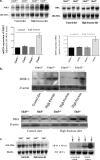Slc2a5 (Glut5) is essential for the absorption of fructose in the intestine and generation of fructose-induced hypertension
- PMID: 19091748
- PMCID: PMC2643499
- DOI: 10.1074/jbc.M808128200
Slc2a5 (Glut5) is essential for the absorption of fructose in the intestine and generation of fructose-induced hypertension
Abstract
The identity of the transporter responsible for fructose absorption in the intestine in vivo and its potential role in fructose-induced hypertension remain speculative. Here we demonstrate that Glut5 (Slc2a5) deletion reduced fructose absorption by approximately 75% in the jejunum and decreased the concentration of serum fructose by approximately 90% relative to wild-type mice on increased dietary fructose. When fed a control (60% starch) diet, Glut5(-/-) mice had normal blood pressure and displayed normal weight gain. However, whereas Glut5(+/+) mice showed enhanced salt absorption in their jejuna in response to luminal fructose and developed systemic hypertension when fed a high fructose (60% fructose) diet for 14 weeks, Glut5(-/-) mice did not display fructose-stimulated salt absorption in their jejuna, and they experienced a significant impairment of nutrient absorption in their intestine with accompanying hypotension as early as 3-5 days after the start of a high fructose diet. Examination of the intestinal tract of Glut5(-/-) mice fed a high fructose diet revealed massive dilatation of the caecum and colon, consistent with severe malabsorption, along with a unique adaptive up-regulation of ion transporters. In contrast to the malabsorption of fructose, Glut5(-/-) mice did not exhibit an absorption defect when fed a high glucose (60% glucose) diet. We conclude that Glut5 is essential for the absorption of fructose in the intestine and plays a fundamental role in the generation of fructose-induced hypertension. Deletion of Glut5 results in a serious nutrient-absorptive defect and volume depletion only when the animals are fed a high fructose diet and is associated with compensatory adaptive up-regulation of ion-absorbing transporters in the colon.
Figures






References
Publication types
MeSH terms
Substances
Grants and funding
LinkOut - more resources
Full Text Sources
Medical
Molecular Biology Databases

